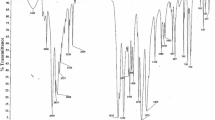Abstract
Meso-5,7,7,12,12,14-hexamethyl-1,4,8,11-tetraazacyclotetradecane (tet-a) — (2E)-2-cyano-2-(hydroxyimino) acetamide (caH) (1:4) (1) is a salt [tet-aH2]2+ ·2[caH]· 2[ca]− containing both neutral and deprotonated acetamide units. The acetamide units of the two types are linked by NH⋯O and OH⋯O hydrogen bonds into negatively charged chains; the chains are connected by the macrocyclic cations to form H-bonded ribbons. Tet-a and 2-(2,6-dioxo-1,2,3,6-tetrahydropyrimidin-4-yl)hydrazinecarboxamide (urH) form a salt of 1:2:2 stoichiometry, [tet-aH2]2+·2[ur]−·2H2O (2). In (2), the deprotonated ur− units form a negatively charged 2D network substructure, and the layers are linked by the cations and water molecules to form a 3D framework. The tetraazamacrocycle shows different modes of the protonation of amine functionalities that depend on a substrate.
Similar content being viewed by others
Abbreviations
- Tet-a:
-
Meso-5,7,7,12,12,14-hexamethyl-1,4,8,11-tetraazacyclotetradecane
- cyclen:
-
1,4,7,10-tetraazacyclododecane
- cyclam:
-
1,4,8,11-tetraazacyclotetradecane
- azacyclam:
-
1,4,6,8,11-pentaazacyclotetradecane
- caH:
-
(2E)-2-cyano-2-(hydroxyimino)acetamide
- urH:
-
2-(2,6-dioxo-1,2,3,6-tetrahydropyrimidin-4-yl)hydrazinecarboxamide
- 18C6:
-
18-crown-6
References
D. E. Ingber, Sci. Amer., 278, No. 1, 48–57 (1998).
E. Kimura, In Progress in Inorganic Chemistry, K. D. Karlin (ed.), 41, 443–491, Wiley, New York (1994); (b) E. Kimura and M. Shionoya, in: Metal Ions in Biological Systems, A. Sigel and H. Sigel (eds.), 33, 29–52, Marcel Dekker, New York (1996); (c) E. Kimura, T. Koike, and M. Shionoya, in: Structure and Bonding: Metal Site in Proteins and Models, P. J. Sadler (ed.), 89, 1–28 (Springer, Berlin (1997); (d) E. Kimura, N. Katsube, T. Koike, M. Shiro, and S. Aoki, Supramol. Chem., 14, 95–102 (2002).
S. Aoki, M. Shiro, T. Koike, and E. Kimura, J. Am. Chem. Soc., 122, 576–584 (2000).
J. H. R. Tucker, M. Shionoya, T. Koike, and E. Kimura, Bull. Chem. Soc. Jpn., 68, 2465–2469 (1995).
P. V. Bernhardt and E. J. Hayes, Inorg. Chem., 42, 1371–1377 (2003).
A. A. Yavolovskii, E. I. Ivanov, and R. Yu. Ivanova, Russ. J. Gen. Chem., 73, 1402/1403 (2003).
Z. Otwinowski and W. Minor, Methods in Enzymology, Vol. 276, Macromolecular Crystallography, Part A, C. W. Carter and R. M. Sweet (eds.), 276, 307–326 (1997).
Bruker Axs Inc., Madison, WI 53719-1173, USA.
G. M. Sheldrick, SHELXS-97_and SHELXL-97: Programs for the Solution and Refinement of Crystal Structures, Univ. Göttingen, Germany (1997).
R. M. Gregson, C. Glidewell, G. Ferguson, and A. J. Lough, Acta Crystallogr., B56, 39–57 (2000).
M. C. Etter, Acc. Chem. Res., 23, 120–126 (1990).
M. S. Fonari, Yu. A. Simonov, Yu. M. Chumakov, et al., Supramol. Chem., 16, 23–30 (2004).
F. H. Allen, Acta Crystallogr., B58, 380–388 (2002).
K. F. Bowes, G. Ferguson, A. J. Lough, and C. Glidewell, ibid., C59, o147–o149 (2003).
N. Arulsamy and D. S. Bohle, J. Org. Chem., 65, 1139–1143 (2000).
K. V. Domasevitch, V. V. Ponomareva, E. B. Rusanov, et al., Inorg. Chim. Acta., 268, 93–101 (1998).
V. V. Ponomareva, V. V. Skopenko, K. V. Domasevitch, et al., Naturforsch, Teil B., 52, 901–905 (1997).
Yu. A. Simonov, M. S. Fonari, J. Lipkowski, et al., J. Inclus. Phenom., 46, 27–35 (2003).
Author information
Authors and Affiliations
Additional information
Original Russian Text Copyright © 2005 by M. S. Fonari, Yu. A. Simonov, Yu. M. Chumakov, E. V. Ganin, A. A. Yavolovskii, G. Bocelli, and M. M. Botoshansky
__________
Translated from Zhurnal Strukturnoi Khimii, Vol. 46, Supplement, pp. S95–S101, 2005.
Rights and permissions
About this article
Cite this article
Fonari, M.S., Simonov, Y.A., Chumakov, Y.M. et al. 1D and 3D supramolecular architectures in the salts of Meso-5,7,7,12,12,14-hexamethyl-1,4,8,11-tetraazacyclotetradecane with (2E)-2-cyano-2-(hydroxyimino)acetamide and 2-(2,6-dioxo-1,2,3,6-tetrahydropyrimidin-4-yl) hydrazinecarboxamide sustained by charge-assisted and conventional hydrogen bonds. J Struct Chem 46 (Suppl 1), S96–S102 (2005). https://doi.org/10.1007/s10947-006-0158-2
Received:
Issue Date:
DOI: https://doi.org/10.1007/s10947-006-0158-2




